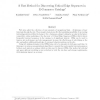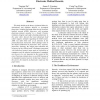1122 search results - page 37 / 225 » Behavioral Extensions of Institutions |
EOR
2007
13 years 7 months ago
2007
Web sites allow the collection of vast amounts of navigational data – clickstreams of user traversals through the site. These massive data stores offer the tantalizing possibil...
CVPR
2011
IEEE
13 years 2 months ago
2011
IEEE
We present an algorithm to simultaneously recover nonrigid shape and camera poses from point correspondences between a reference shape and a sequence of input images. The key nove...
EVI
2010
13 years 2 months ago
2010
This article presents results from an evaluation of the collective neuro-evolution (CONE) controller design method. CONE solves collective behavior tasks, and increases task perfor...
HICSS
2007
IEEE
14 years 1 months ago
2007
IEEE
This study builds on the theory of planned behavior, institutional and diffusion theories to investigate physicians’ attitudes and usage behaviors of electronic medical records ...
AAAI
2007
13 years 9 months ago
2007
The goal of the Virtual Humans Project at the University of Southern California’s Institute for Creative Technologies is to enrich virtual training environments with virtual hum...


